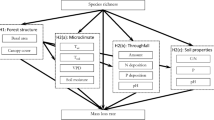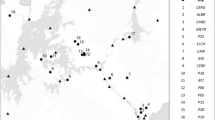Abstract
Over the past decade an increasing amount of research has sought to understand how the diversity of species in an ecosystem can influence fluxes of biologically important materials, such as the decomposition of organic matter and recycling of nutrients. Generalities among studies have remained elusive, perhaps because experimental manipulations have been performed at relatively small spatial scales where site-specific variation generates patterns that appear idiosyncratic. One approach for seeking generality is to perform parallel experiments at different sites using an identical species pool. Here we report results from a study where we manipulated the diversity of leaf litter from the same six dominant tree species in the litter layer of three forested ecosystems. These ecosystems spanned a 300 km latitudinal transect in Wisconsin, USA, and were characterized by a large gradient in temperature and moisture, and thus, rates of decomposition. After allowing combinations of one, two, four, and six species of leaf litter to decompose for 1 year, we found that increasing leaf litter richness led to slower rates of decomposition and higher fractions of nitrogen lost from litter. Across all sites, climate and initial litter chemistry explained more of the variation in decomposition rates than did litter richness. Effects of leaf litter diversity were non-additive, meaning they were greater than expected from the impacts of individual species, and appeared to be strongly influenced by the presence/absence of just 1–2 species (Tilia americana and Acer saccharum). The rate of decomposition of these two species was highly site-specific, which led to strong negative effects of litter richness only being observed at the southernmost sites where T. americana and A. saccharum decomposed more quickly. In contrast, litter diversity increased nitrogen loss at the northernmost sites where decomposition of T. americana was notably slowed. Our study shows that species diversity affected at least one of the two litter processes at each site along this 300-km gradient, but the exact nature of these effects were spatially variable because the performance of individual species changed across the heterogeneous landscape.






Similar content being viewed by others
References
Amarasekare P (2003) Competitive coexistence in spatially structured environments: a synthesis. Ecol Lett 6:1109–1122
Bengtsson J, Engelhardt KAM, Giller PS, Hobbie SE, Lawrence D, Levine JM, Vila M, Wolters V (2002) Slippin’ and slidin’ between the scales: the scaling components of biodiversity–ecosystem functioning relations. In: Loreau MA, Inchausti P, Naeem S (eds) Biodiversity and ecosystem functioning: synthesis and perspectives, Oxford University Press, pp 209–220
Blair JM, Parmelee RW, Beare MH (1990) Decay rates, nitrogen fluxes, and decomposer communities of single- and mixed-species foliar litter. Ecology 71:1976–1985
Briones MJI, Ineson P (1996) Decomposition of Eucalyptus leaves in litter mixtures. Soil Biol Biochem 28:1381–1388
Cardinale BJ, Ives AR, Inchausti P (2004) Effects of species diversity on the primary productivity of ecosystems: extending our spatial and temporal scales of inference. Oikos 104:437–450
Cardinale BJ, Nelson K, Palmer MA (2000) Linking species diversity to the functioning of ecosystems: on the importance of environmental context. Oikos 91:175–183
Caswell H, Cohen JE (1991) Disturbance, interspecific interaction and diversity in meta-populations. Biol J Linn Soc 42:193–218
Chapin FS, Sala OE, Burke IC, Grime JP, Hooper DU, Lauenroth WK, Lombard A, Mooney HA, Mosier AR, Naeem S, Pacala SW, Roy J, Steffen WL, Tilman D (1998) Ecosystem consequences of changing biodiversity. Bioscience 48:45–52
Chesson P (2000) General theory of competitive coexistence in spatially-varying environments. Theor Popul Biol 58:211–237
Coleman DC, Crossley DA Jr (1996) Fundamentals of soil ecology. Academic Press, San Diego
Fyles JH, Fyles IH (1993) Interaction of Douglas-fir with red alder and salal foliage litter during decomposition. Can J For Res 23:358–361
Gartner TB, Cardon ZG (2004) Decomposition dynamics in mixed-species leaf litter. Oikos 104:230–246
Hanski I (1989) Metapopulation dynamics: does it help to have more of the same? Trends Ecol Evol 4:113–114
Hastings A (1991) Structured models of metapopulation dynamics. Biol J Linn Soc 42:57–71
Hattenschwiler S,Tiunov AV, Scheu S (2005) Biodiversity and litter decomposition in terrestrial ecosystems. Annu Rev Ecol Evol Syst 36:191–218
Hector A, Beale AG, Minns A, Otway SJ, Lawton JH (2000) Consequences of the reduction of plant diversity for litter decomposition: effects through litter quality and microenvironment. Oikos 90:357–371
Hector A, Schmid B, Beierkuhnlein C, Caldeira MC, Diemer M, Dimitrakopoulos PG, Finn JA, Freitas H, Giller PS, Good J, Harris R, Hogberg P, Huss-Danell K, Joshi J, Jumpponen A, Korner C, Leadley PW, Loreau M, Minns A, Mulder CPH, O'Donovan G, Otway SJ, Pereira JS, Prinz A, Read DJ, Scherer-Lorenzen M, Schulze ED, Siamantziouras ASD, Spehn EM, Terry AC, Troumbis AY, Woodward FI, Yachi S, Lawton JH (1999) Plant diversity and productivity experiments in European grasslands. Science 286:1123–1127
Hobbie SE (2005) Contrasting effects of substrate and fertilizer nitrogen on the early stages of litter decomposition. Ecosystems 8:644–656
Hooper DU, Chapin FA, Ewel JJ, Hector A, Inchausti P, Lavorel S, Lawton JH, Lodge DM, Loreau M, Naeem S, Schmid B, Setala H, Symstad AJ, Vandermeer J, Wardle DA (2005) Effects of biodiversity on ecosystem functioning: a consensus of current knowledge. Ecol Monogr 75:3–35
Hoorens B, Aerts R, Stroetenga M (2002) Litter quality and interactive effects in litter mixtures: more negative interactions under elevated CO2? J Ecol 90:1009–1016
Hoorens B, Aerts R, Stroetenga M (2003) Does initial litter chemistry explain litter mixture effects on decomposition? Oecologia 137:578–586
Huston MA (1997) Hidden treatments in ecological experiments: re-evaluating the ecosystem function of biodiversity. Oecologia 110:449–460
Jablonski D (2004) Extinction: past and present. Nature 427:589–589
Kolasa J, Pickett ST (1991) Ecological heterogeneity. Springer-Verlag, New York
Loreau M (1998) Separating sampling and other effects in biodiversity experiments. Oikos 82:600–602
Loreau, M (2000) Biodiversity and ecosystem functioning: recent theoretical advances. Oikos 91:3–17
Loreau M (2001) Microbial diversity, producer–decomposer interactions and ecosystem processes: a theoretical model. Proc R Soc Lond Ser B 268:303–309
Loreau M, Mouquet N, Gonzalez A (2003) Biodiversity as spatial insurance in heterogeneous landscapes. Proc Natl Acad Sci 100:12765–12770
Loreau M, Naeem S, Inchausti P, Bengtsson J, Grime JP, Hector A, Hooper DU, Huston MA, Raffaelli D, Schmid B, Tilman D, Wardle DA (2001) Biodiversity and ecosystem functioning: current knowledge and future challenges. Science 294:804–808
McTiernan KB, Ineson P, Coward PA (1997) Respiration and nutrient release from tree leaf litter mixtures. Oikos 78:527–538
Meentemeyer V (1978) Macroclimate and lignin control of litter decomposition rates. Ecology 59:465–472
Mouquet N, Moore JL, Loreau M (2002) Plant species richness and community productivity: why the mechanism that promotes coexistence matters. Ecol Lett 5:56–65
Naeem S (2002) Ecosystem consequences of biodiversity loss: the evolution of a paradigm. Ecology 83:1537–1552
Pimm SL, Russell GJ, Gittleman JL, Brooks TM (1995) The future of biodiversity. Science 269:347–350
Ricciardi A, Rasmussen JB (1999) Extinction rates of North American freshwater fauna. Conserv Biol 13:1220–1222
Rosenzweig ML (2001) Loss of speciation rate will impoverish future diversity. PNAS 98:5404–5410
Sala OE, Chapin FS, Armesto JJ, Berlow E, Bloomfield J, Dirzo R, Huber-Sanwald E, Huenneke LF, Jackson RB, Kinzig AP, Leemans R, Lodge DM, Mooney HA, Oesterheld M, Poff NL, Sykes MT, Walker BH, Walker M, Wall DH (2000) Global biodiversity scenarios for the year 2100. Science 287:1770–1774
Salamanca EF, Kaneko N, Natagiri S (1998) Effects of leaf litter mixtures on the decomposition of Quercus serrata and Pinus densiflora using field and laboratory microcosm methods. Ecol Eng 10:53–73
Sax DF, Gaines SD (2003) Species diversity: from global decreases to local increases. Trends Ecol Evol 18:561–566
Schlapfer F, Schmid B (1999) Ecosystem effects of biodiversity: a classification of hypotheses and exploration of empirical results. Ecol Appl 9:893–912
Schmid B, Joshi J, Schlapfer F (2001) Empirical evidence for biodiversity–ecosystem functioning relationships. In: Kinzig AP, Pacala SW, Tilman D (eds) Empirical progress and theoretical extensions. The functional consequences of biodiversity: monographs in population biology 33. Princeton University Press, Princeton, NJ, pp 120–150
Schwartz MW, Brigham CA, Hoeksema JD, Lyons KG, Mills MH, van Mantgem PJ (2000) Linking biodiversity to ecosystem function: implications for conservation ecology. Oecologia 122:297–305
Srivastava DS, Vellend M (2005) Biodiversity–ecosystem function research: is it relevant to conservation? Annu Rev Ecol Evol Syst 36:267–294
Swift MJ, Heal OW, Anderson JM (1979) Decomposition in terrestrial ecosystesm. University of California Press, Berkeley
Symstad AJ, Tilman D (2001) Diversity loss, recruitment limitation, and ecosystem functioning: lessons learned from a removal experiment. Oikos 92:424–435
Symstad AJ, Chapin FS, Wall DH, Gross KL, Huenneke LF, Mittelbach GG, Peters DPC, Tilman D (2003) Long-term and large-scale perspectives on the relationship between biodiversity and ecosystem functioning. Bioscience 53:89–98
Thomas CA, Cameron A, Green RE, Bakkenes M, Beaumont LJ, Collingham YC, Erasmus BFN, de Siqueira MF, Grainger A, Hannah L, Hughes L, Huntley B, van Jaarsveld AS, Midgley GF, Miles L, Ortega-Huerta MA, Peterson AT, Phillips OL, Williams SE (2004) Extinction risk from climate change. Nature 427:145–148
Tilman D (1999) The ecological consequences of changes in biodiversity: a search for general principles. Ecology 80:1455–1474
Tilman D, Kareiva P (1997) Spatial ecology: the role of space in population dynamics and interspecific interactions. Princeton University Press, Princeton
Tilman D, May RM, Lehman CL, Nowak MA (1994) Habitat destruction and the extinction debt. Nature 371:65–66
Vitousek PM, Mooney HA, Lubchenco J, Melillo JM (1997) Human domination of Earth’s ecosystems. Science 277:494–499
Wardle DA, Nicholson KS (1996) Synergistic effects of grassland plant species on soil microbial biomass and activity: implications for ecosystem-level effects of enriched plant diversity. Funct Ecol 10:410–416
Wardle DA, Bonner KI, Nicholson KS (1997) Biodiversity and plant litter: experimental evidence which does not support the view that enhanced species richness improves ecosystem function. Oikos 79:247–258
Wardle DA, Huston MA, Grime JP, Berendse F, Garnier E, Lauenroth WK, Setala H, Wilson SD (2000) Biodiversity and ecosystem function: an issue in ecology. Bull Ecol Soc Am 81:235–239
Wardle DA, Bardgett RD, Klironomos JN, Setala H, van der Putten WH, Wall DH (2004) Ecological linkages between aboveground and belowground biota. Science 304:1629–1633
Acknowledgements
We would like to thank A. Ives and R. Lindroth for use of their equipment, and J. Schimel for comments that improved this paper. Funding for M.D.M. was provided by NSF DEB-0344019.
Author information
Authors and Affiliations
Corresponding author
Rights and permissions
About this article
Cite this article
Madritch, M.D., Cardinale, B.J. Impacts of tree species diversity on litter decomposition in northern temperate forests of Wisconsin, USA: a multi-site experiment along a latitudinal gradient. Plant Soil 292, 147–159 (2007). https://doi.org/10.1007/s11104-007-9209-5
Received:
Accepted:
Published:
Issue Date:
DOI: https://doi.org/10.1007/s11104-007-9209-5




